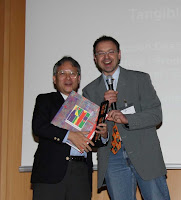 On Sunday afternoon I flew to
On Sunday afternoon I flew to
We have rented a house in the
 The conference is massive – 2300 people. There is a lot of interesting work and hence it is not feasible to cover it in a few sentences. Nevertheless there are some random pointers:
The conference is massive – 2300 people. There is a lot of interesting work and hence it is not feasible to cover it in a few sentences. Nevertheless there are some random pointers:
In the keynote a reference to an old reading machine by Athanasius Kircher was mentioned.
Mouse Mischief – educational software – 30 mice connected to 1 PC – cool!
Reality based interaction – conceptual paper – arguing that things should behaves as in the real world – interesting concept bringing together many new UI ideas
 Inflatable mouse – cool technology from Korea– interesting use cases – we could integrate this in some of our projects (not inflating the mouse but inflating other things)
Inflatable mouse – cool technology from Korea– interesting use cases – we could integrate this in some of our projects (not inflating the mouse but inflating other things)
Multiple Maps – Synthesizing many maps – could be interesting for new navigation functions
Rub the Stane – interactive surfaces – detection of scratching noises only using a microphone
 Usability evaluation considered harmful – the every-year discussion on how to make CHI more interesting continues
Usability evaluation considered harmful – the every-year discussion on how to make CHI more interesting continues
It seems there is currently some work going on looking at technologies in religious practice. Over lunch we had developed interesting ideas towards remote access to multimedia information (e.g. services of ‘once’ local church) and sharing awareness. This domain is intriguing because churches often form tight communities and content is regularly produced and available. Perhaps we should follow up on this with a project…
Dairy study on mobile information needs – good base literature of what information people need/use when they are mobile
K-Sketch – cool sketching technique.
Crowdsourcing user studies – reminded me of my visit at http://humangrid.eu
Lean and Zoom – simple idea – you come close it gets bigger – nicely done











